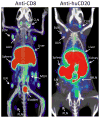In vivo imaging with antibodies and engineered fragments
- PMID: 25934435
- PMCID: PMC4529772
- DOI: 10.1016/j.molimm.2015.04.001
In vivo imaging with antibodies and engineered fragments
Abstract
Antibodies have clearly demonstrated their utility as therapeutics, providing highly selective and effective drugs to treat diseases in oncology, hematology, cardiology, immunology and autoimmunity, and infectious diseases. More recently, a pressing need for equally specific and targeted imaging agents for assessing disease in vivo, in preclinical models and patients, has emerged. This review summarizes strategies for developing and optimizing antibodies as targeted probes for use in non-invasive imaging using radioactive, optical, magnetic resonance, and ultrasound approaches. Recent advances in engineered antibody fragments and scaffolds, conjugation and labeling methods, and multimodality probes are highlighted. Importantly, antibody-based imaging probes are seeing new applications in detection and quantitation of cell surface biomarkers, imaging specific responses to targeted therapies, and monitoring immune responses in oncology and other diseases. Antibody-based imaging will provide essential tools to facilitate the transition to truly precision medicine.
Keywords: Antibody fragments; Image-guided surgery; ImmunoPET; Molecular imaging.
Copyright © 2015 Elsevier Ltd. All rights reserved.
Figures







References
-
- Atreya R, Neumann H, Neufert C, Waldner MJ, Billmeier U, Zopf Y, Willma M, App C, Münster T, Kessler H, Maas S, Gebhardt B, Heimke-Brinck R, Reuter E, Dörje F, Rau TT, Uter W, Wang TD, Kiesslich R, Vieth M, Hannappel E, Neurath MF. In vivo imaging using fluorescent antibodies to tumor necrosis factor predicts therapeutic response in Crohn’s disease. Nat Med. 2014;20:313–8. doi: 10.1038/nm.3462. - DOI - PMC - PubMed
-
- Axup JY, Bajjuri KM, Ritland M, Hutchins BM, Kim CH, Kazane SA, Halder R, Forsyth JS, Santidrian AF, Stafin K, Lu Y, Tran H, Seller AJ, Biroc SL, Szydlik A, Pinkstaff JK, Tian F, Sinha SC, Felding-Habermann B, Smider VV, Schultz PG. Synthesis of site-specific antibody-drug conjugates using unnatural amino acids. Proc Natl Acad Sci USA. 2012;109:16101–6. doi: 10.1073/pnas.1211023109. - DOI - PMC - PubMed
Publication types
MeSH terms
Substances
Grants and funding
LinkOut - more resources
Full Text Sources
Other Literature Sources
Medical

